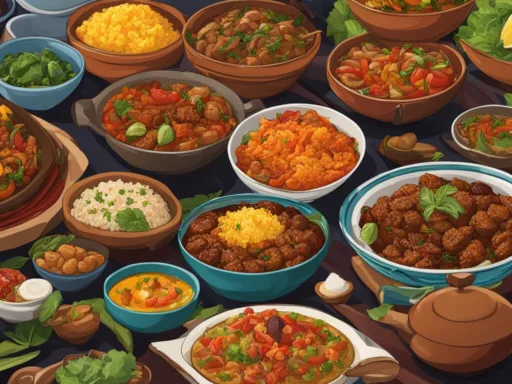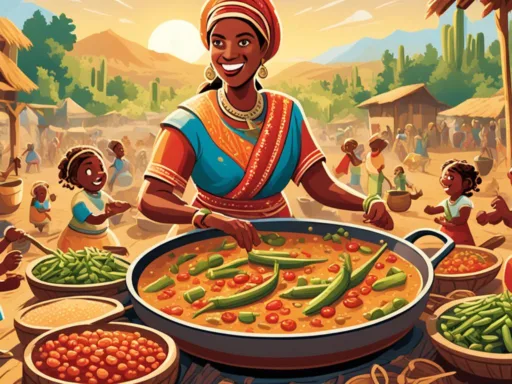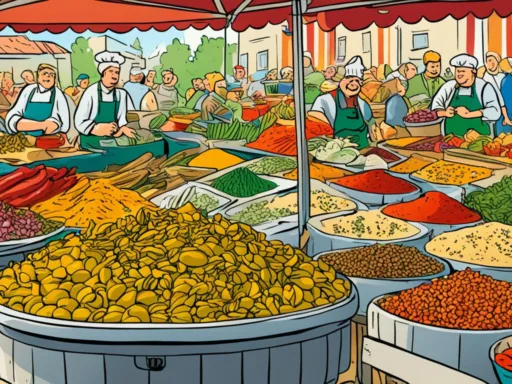Did you know that India is home to over 30 cuisines, each with its own unique flavor profile? Embarking on an Indian Food Journey isn’t just about the pleasure of eating; it’s a passport to taste the heritage of a civilization spanning over five millennia. From the sizzle of street-side frying pans to the symphonic chorus of spices in domestic kitchens, this Indian cuisine exploration is an adventure for the senses. As we uncover the layers of authentic Indian dishes, we discover more than flavors—we unravel stories of empires, trade routes, and the timeless art of culinary mastery. In this gastronomic sojourn, every bite offers a savory echo of history, a whisper of tradition, and the vivid taste of India.
Key Takeaways
- An Indian Food Journey presents a chance to experience the nation’s vast culinary diversity.
- Uncovering authentic Indian dishes is as much about the culture as it is about taste.
- Every region in India contributes uniquely to the country’s rich meals and eating experiences.
- The taste of India is defined by its generous use of spices and regional ingredients.
- Indian cuisine exploration offers a fusion of flavors that appeal to both adventurous and traditional palates.
The Enchantment of Indian Cuisine: A Historical Overview
The Indian Food Journey is as much a historical quest as it is a culinary one. Exploring the historical roots of Indian food is akin to leafing through the pages of the country’s rich past, each dish offering a glimpse into epochs stretching from the ancient to the contemporary. Indian cuisine presents a palimpsest of flavors, where every ingredient tells a story, every spice a chapter in a saga of cultural convergence and evolution.
Tracing the Roots: Indus Valley to Modern Day
The timeline of Indian gastronomy begins with the agrarian society of the Indus Valley Civilization, focusing on crops like wheat, barley, and millet, and the culinary use of native vegetables and fruits. These humble beginnings laid the foundation for what would become a treasure trove of traditional Indian recipes.
Foreign Influences: Mughals to the British Empire
As empires rose and trade routes expanded, Indian food was forever transformed by foreign influences. The Mughals introduced rich gravies and pilafs, while the British colonial period brought tea and new baking techniques. Each wave of influence seamlessly woven into the existing culinary tapestry, leaving an indelible imprint on Indian flavors and customs.
The annals of India’s epicurean history reveal a dynamic interplay of native ingenuity and diverse external influences, giving rise to a cuisine that’s as varied as its many languages and traditions.
Here’s a snapshot capturing the iconic influences on Indian cuisine over the millennia:
| Time Period | Cultural Influence | Key Contributions to Indian Cuisine |
|---|---|---|
| 2600–1900 BCE | Indus Valley Civilization | Use of native grains and vegetables |
| 16th–19th Century | Mughal Empire | Introduction of spices, nuts, and fruits used in rich gravies |
| 1858–1947 | British Colonial Rule | Tea cultivation, widespread use of potato, refined flour, and bread |
If one were to speak of the soul of Indian cuisine, it would narrate a tale of natural abundance, historical richness, and a continuous reinvention that heralds its place at the world’s table. Join us in celebrating the Indian Food Journey, as we savor the legacy and innovation that are the cornerstones of India’s gastronomical identity.
A Culinary Map of India: Regional Food Diversity
If there’s one adventure food lovers should embark on, it’s a regional Indian food discovery. This culinary voyage through India is not just a journey through the various states and territories but a passage through time and taste, bringing to the fore a treasure trove of authentic Indian dishes. Let’s delve into the distinctive flavors that make India’s regional cuisine so spectacularly diverse.

Indian cuisine’s regional diversity is vast and varied. To the north, you’ll find thick, creamy curries and slow-cooked tandoori dishes, while the south offers a completely different fare with its lighter, coconut-based gravies and fermented rice batters. The east of India is renowned for its sweet treats and seafood, whereas the west brings bold, spicy flavors into the mix.
| Region | Signature Ingredients | Popular Dishes |
|---|---|---|
| North India | Yogurt, Ghee, Saffron | Butter Chicken, Rogan Josh, Naan |
| South India | Rice, Tamarind, Coconut | Dosa, Sambar, Pongal |
| East India | Mustard Oil, Panch Phoron | Rasgulla, Fish Curry, Misti Doi |
| West India | Cumin, Coriander, Chillies | Pav Bhaji, Dhokla, Goan Fish Curry |
Every dish tells a story—of the land, the people, and the history that has helped shape the state’s culinary identity. Food connoisseurs celebrate this diversity, often venturing into the hinterlands to sample and savor the unique tastes and preparations. Whether you’re dining at a local dhaba or enjoying a street food tour, the authenticity and richness of India’s regional plates are always an unforgettable experience.
Discovery of India’s regional cuisine is much like turning the pages of an elaborate menu crafted by history itself, offering an array of flavors that are as distinct as the cultures they originate from.
So, when you prepare for your next culinary excursion, think of India not just as a country but as a collection of cuisines that together weave the rich tapestry that is Indian food. There’s a whole subcontinent of flavors waiting to be explored and cherished.
Flavors of the North: Creamy Curries and Tandoori Techniques
The northern region of India tempts the palate with a taste of India embodied in its dairy-rich gravies and robust tandoori cooking. The warmth of these authentic Indian dishes beckons food aficionados to experience the richness and complexity traditional Indian recipes have to offer. It’s a culinary journey revealing the North’s inherent opulence and artistry in its food culture.

Mughlai Splendor: Biryani and Kebabs
The essence of Mughlai cuisine lies in its aromatic biryanis and succulent kebabs that stand tall as gastronomic icons. These dishes, crafted with precision and a myriad of spices, represent the regal legacy and exquisite flavors imbued within traditional Indian recipes.
- Chicken Biryani – Layers of fragrant rice and marinated poultry, mingled with saffron and herbs, presenting a feast for the senses.
- Galouti Kebabs – Melt-in-the-mouth delicacies finely grounded with tender meat and a harmony of spices, hailing from the royal kitchens.
Street Food Culture: Delhi’s Chaat and Amritsari Kulchas
In the bustling streets of Delhi, the tangy and tantalizing sensation of Chaat serves a burst of flavors synonymous with the taste of India. Further north, in the heart of Amritsar, the famed Amritsari Kulchas offer a crispy, buttery embrace that brings the authenticity of authentic Indian dishes to the forefront of street cuisine.
- Aloo Tikki Chaat – A crispy potato patty base, drizzled with mint and tamarind chutneys, adorned with fresh yoghurt and sev.
- Amritsari Kulcha – Flaky flatbread stuffed with spiced potatoes and onions, traditionally cooked in a tandoor, and served with dollops of butter.
Indian Food Journey: Staples and Specialties of South India
Embark on a culinary voyage through India that tantalizes your taste buds with the vibrant and distinct flavors of South Indian cuisine. Renowned for its diversity and rich profiles, every dish is a homage to the taste of India, offering a range of textures and tastes that are profoundly embedded in the region’s cultural fabric.

From the bustling streets of Chennai to the serene backwaters of Kerala, South India invites food lovers to traverse its culinary landscape through rice-based staples and variety-packed chutneys. Experience the thrill of savoring dishes that brim with bold flavors and traditional spices, all while navigating the harmonious blend of the six essential tastes: sweet, sour, salty, bitter, pungent, and astringent.
| Staple | Specialty | Signature Ingredients |
|---|---|---|
| Idli | Sambar | Lentils, Rice, Tamarind |
| Dosa | Chettinad Chicken | Rice, Black Peppercorns, Coconut |
| Rice | Hyderabadi Biryani | Saffron, Rice, Marinated Meat |
| Uttapam | Malabari Parota | Rice, Coconut, Fermented Batter |
Contrasting the creamy gravies of the north, the staples and specialties of South India are characterized by their reliance on steaming and fermentation, resulting in lighter and more digestible meals. Substantial use of coconut milk and oil, curry leaves, and tamarind gives the dishes a distinct taste that is at once refreshing and comforting.
- Curry Leaves: Offering a nutty, pungent flavor to enhance the dish’s aroma.
- Mustard Seeds: Used as a tempering agent, releasing a rich, nutty taste when fried.
- Asafoetida (Hing): A pinch adds a powerful, onion-like fragrance and flavor.
For those eager to dive deep into the culinary traditions of this lush region, an exploration of South Indian cuisine is certain to reveal the soul of Indian gastronomy, replete with meals that are as nourishing as they are delicious.
Fresh and Fiery: The Coastal Cuisines of East India
The regional Indian food discovery expands into the vibrant eastern coastline, where the culinary voyage through India reveals a fascinating blend of sweet and piquant flavors. The coastal regions of East India, particularly West Bengal, Odisha, and Andhra Pradesh, offer a distinct palatal experience that is both authentic and tantalizing.
Here, food is an artistic expression, steeped deeply in local traditions and the bountiful harvest of the sea. Each dish tells a story—a narrative woven from the fabric of history, culture, and regional abundance. This section of our gastronomic journey invites you to savor the essence of East India’s coastal delicacies.
West Bengal’s Sweet Tooth: Rasgulla and Sandesh

In the lanes of Kolkata and beyond, the love for sweets is legendary. The region’s confectioneries craft syrupy wonders, often embodying the joyous spirit of Bengali festivals and celebrations. Rasgulla, the quintessential Bengali sweet, is a marvel of simplicity—soft, spongy cheese balls soaked in light sugar syrup. On the other hand, Sandesh features the delicate balance of sweetness with the rich, crumbly texture of paneer, artistically molded and often adorned with pistachios or saffron.
Seafood Delicacies: Odisha and Andhra’s Love for Fish
The coastal repertoire continues, casting the net wider to explore the seafood delights of Odisha and Andhra Pradesh. Odisha’s proximity to the Bay of Bengal is celebrated with dishes like Machher Jhol (Fish Curry), a comforting fish stew simmered with potatoes, tomatoes, and a variety of spices that lend it a distinctive fiery tang.
Andhra Pradesh, with its long coastline, is known for its hot and spicy flavors. The state’s culinary tradition boasts an array of seafood specialties, enriched with a heady mix of local spices. The affinity for chili is evident in dishes like the fiery Chepala Pulusu, a fish curry that is both zesty and heartwarming, perfect for those on a culinary voyage through India in search of bold flavors.
Together, these regions constitute integral chapters of the traditional Indian recipes anthology. They celebrate the diversity and richness of the country’s vast culinary landscape, from the simplest sweets to the most elaborate seafood stews. Engage your senses in this spirited and sensational exploration of East India’s coastal flavors, where every bite is a journey in itself.
Authentic Indian Dishes: The Vegetarian Heaven of West India
For those seeking an Indian cooking experience that tantalizes the taste buds with a burst of vegetarian flavors, the western region of India stands as a culinary paradise. It is in this part of the country where the vibrancy of the local street food culture and the variety of scrumptious vegetarian fares truly encapsulate the taste of India. This part of our gastronomic quest brings to light the regional Indian food discovery that characterizes West India as a treasure trove of authentic Indian dishes.
Gujarat’s Vegetarian Delicacies: Dhokla and Thepla
Renowned for its deeply traditional and overwhelmingly vegetarian cuisine, Gujarat is a state that prides itself on dishes that are as nurturing as they are flavorful. Dhokla, a steamed and spongy cake made of rice and chickpea flour, is a perfect embodiment of the region’s preference for light yet satisfying meals. Often enjoyed as a breakfast item or snack, Dhokla serves as a testament to the delicate balance of wellness and indulgence that is the hallmark of Gujarati cuisine.
Thepla, on the other hand, speaks to the rustic charm of Gujarat’s kitchen craft. These soft flatbreads, infused with spices and sometimes herbs like fenugreek, accompany a variety of chutneys and pickles, making them a versatile element of any meal and an essential part of the Indian cooking experience.
Mumbai’s Street Food Scene: Vada Pav and Bhel Puri
Mumbai, the bustling metropolis, presents an entirely different palette of flavors with its iconic street food. One cannot talk about Mumbai’s food scene without mentioning the legendary Vada Pav, often hailed as the city’s signature street food. This humble yet delectable snack consists of a deep-fried potato dumpling tucked inside a soft bread bun, paired with spicy and sweet chutneys. It exemplifies the fast-paced and diverse nature of Mumbai and its capability to offer a gratifying culinary experience that is both accessible and delicious.
Bhel Puri, a piquant and tangy mix of puffed rice, vegetables, and a variety of chutneys, is not just a snack; it’s an experience. As a dish that bursts with flavors and textures in every mouthful, Bhel Puri encapsulates the multicultural vibrancy that defines Mumbai, thereby enhancing the overall regional Indian food discovery for any food enthusiast.
- Dhokla: Light, savory cake perfect for breakfast or snacks
- Thepla: Flavored flatbreads ideal for versatile pairings
- Vada Pav: Mumbai’s iconic street-side burger
- Bhel Puri: Tangy and crispy puffed rice mix, a true taste of Mumbai’s street culture
Indian Cuisine Exploration Through Its Spices and Ingredients
The quintessence of Indian cuisine exploration lies not just in its complex flavors and vibrant presentations but profoundly in the aromatic tapestry woven by its spices and ingredients. A true taste of India can be experienced in the diversity of its spice-laden landscapes, where each fragment of Indian terrain whispers its own culinary secrets through distinct, locally sourced components and time-honored practices.
Among the pantheon of Indian spices, some have held their ground as indispensable agents of flavor. These include the earthy turmeric, the sharp cumin, the citrusy coriander, the warm cardamom, and the fiery chilies. From tempering hot oil with mustard seeds to infusing curries with curry leaves, these ingredients are not mere add-ons but the soul of traditional Indian recipes.
- Turmeric: Known for its anti-inflammatory properties and vibrant hue.
- Cumin: Adds a distinctive smoky taste and is essential in spice blends.
- Coriander: Offers a lemony touch that complements both sweet and savory dishes.
- Cardamom: Its aromatic essence is a staple in sweets and chai tea.
- Chilies: Responsible for the kick that characterizes many Indian dishes.
Embedded within these ingredients are the stories of various regions, each contributing to the rich tapestry that makes up Indian cuisine. Below is a table that encapsulates the essence of some pivotal Indian spices and their regional prominence:
| Spice | Region | Significance |
|---|---|---|
| Turmeric | All over India | Color, healing properties, integral to curries |
| Cumin | North and West India | Grounded into masalas, key for tempering |
| Coriander | South and East India | Used as garnish and ground into chutneys |
| Cardamom | South India (Kerala) | Infuses sweets and chai with a sweet-spicy flavor |
| Chilies | Andhra Pradesh, Nagaland | Introduces heat and sharpness to dishes |
To further immerse oneself in the Indian cuisine exploration, one must observe the symphony of these spices in action, from the bustling kitchens of Mumbai serving fiery street food to the tranquil settings of a Kerala backwater home where a fish curry simmers, delicately seasoned with freshly grounded spices.
Embrace the journey through the spice-infused streets of India; allow the colors, aromas, and tastes to envelop your senses. It is through the blend and balance of these spices and ingredients that the truest and most accurate taste of India emerges, painting a landscape of flavors that is as diverse as the country itself.
Traditional Indian Recipes: The Art of Cooking with Spices
Embarking on a culinary voyage through India, the quintessence of its flavorful cuisine can be found in the careful and deliberate seasoning of its dishes. The spices that define traditional Indian recipes aren’t merely ingredients; they are the soul of each dish, rendering an allure that beckons the taste buds to a sensational Indian cooking experience.
Beyond a mere addition, spices in Indian cooking represent tradition, healing, and the essence of regional flavors. Let’s delve deeper into the tapestry of taste and aroma woven by the three essential spices that are the heart of any Indian kitchen.
Curry Crafting: The Mastery of Mixes and Masalas
Master chefs and home cooks alike revel in the crafting of curries, where the subtlety of spice mixes, known as masalas, can transform a simple dish into a profound statement of flavor. These masalas range from the ubiquitous Garam Masala to region-specific blends such as Madrasi Masala, coalescing a vast spectrum of spices that bring depth to every morsel.
The Essential Trio: Turmeric, Cumin, and Coriander
At the core of countless traditional Indian recipes, turmeric, cumin, and coriander form an indispensable trio. These spices not only add distinct flavors but also encapsulate the healthful philosophies of Indian cooking.
| Spice | Primary Flavors | Health Benefits |
|---|---|---|
| Turmeric | Warm, bitter, earthy | Anti-inflammatory, antioxidant properties |
| Cumin | Nutty, warming, earthiness | Improves digestion, boosts immunity |
| Coriander | Mild, citrusy | Manages diabetes, promotes heart health |
The synergy of these spices not only crafts an unforgettable culinary signature but also supports well-being, making every meal a harmonious blend of taste and health. Diving into the culinary voyage through India is truly a holistic experience, where every ingredient is selected for both its flavor profile and its life-enhancing properties.
Indian Cooking Experience: From Temple Kitchens to Home Recipes
An Indian Food Journey is deeply interwoven with the country’s spiritual heritage and domestic warmth. The Indian cooking experience extends far beyond the simple preparation of food, embracing a world where each meal is a devout offering and a celebration of culture. Within the hallowed confines of temple kitchens, you’ll find prasad, a sanctified food that’s a testament to India’s spiritual practices. But these experiences also permeate the bustling homes across India, where generations pass down their authentic Indian dishes through recipes steeped in tradition and familial love.
The reverence for vegetarian dishes in these sacred spaces mirrors the country’s diverse palate, offering a sensory pilgrimage to all visitors. To illustrate this point, let’s consider a comparable table of dishes typically served in temples versus those prepared in Indian homes:
| Temple Dishes | Home Cooked Meals |
|---|---|
| Kheer (Rice Pudding) | Chole (Spiced Chickpeas) |
| Halwa (Semolina Dessert) | Rogan Josh (Aromatic Lamb Dish) |
| Ladoo (Sweet Flour Balls) | Dal Makhani (Creamy Lentils) |
| Puri (Fried Flatbread) | Palak Paneer (Spinach and Cheese) |
The table above not only showcases a variety of dishes but also emphasizes the adaptability and regional interpretation of recipes that make the Indian cooking experience a perpetual adventure. Whether it is the prasad offered to the deities or the sumptuous spread in an Indian dining room, each dish carries the essence of India’s rich culinary heritage.
As a part of the Indian Food Journey, visitors and locals alike learn to cook these authentic Indian dishes through interactive sessions, which often leads to an appreciation of the ingredients and techniques that form the backbone of Indian cuisine. This journey is as much about the tantalizing tastes as it is about the stories and customs that are served along with every meal.
Conclusion: The Ongoing Evolution of Indian Cuisine
The journey across the vast and vibrant landscape of Indian cuisine underscores a profound truth: this culinary tradition, steeped in history and bursting with flavors, is not static. Indeed, as each region in India presents its distinctive culinary creations, a continued narrative unfolds—one that reveals not only a deep reverence for heritage but also an inspiring willingness to embrace change. This culinary voyage through India has brought to light the myriad ways in which Indian cuisine exploration enriches the senses and connects cultures.
Celebrating Culinary Diversity: India’s Rich Food Heritage
Embarking on an Indian Food Journey is akin to attending a grand feast that celebrates India’s rich food heritage with every bite. From the tandoori charm of the North to the coconut-infused creations of the South, each dish tells a story of regional pride and communal harmony. The diversity is as splendid as it is satisfying, serving not just a meal but an experience that stays with the traveler long after the last morsel is relished.
Global Impact: Indian Cuisine’s Influence on the World Stage
The global impact of Indian cuisine is palpable. Restaurants worldwide dish out an array of Indian specialties, adapting and integrating traditional recipes into local tastes, yet leaving the soul of the cuisine intact. As Indian flavors continue to weave their way through the culinary tapestry of nations, they champion a diverse and historic culture. This gastronomic ambassadorship is proof that an Indian Food Journey is not confined to geographical borders—it’s a global sensation that continues to evolve and captivate, one plate at a time.
FAQ
What is an Indian Food Journey?
How has history shaped Indian cuisine?
Can you describe the regional diversity in Indian cuisine?
What are some iconic dishes from Northern India?
What distinguishes South Indian cuisine from other regions?
What types of foods are unique to East India?
What makes West Indian vegetarian cuisine stand out?
How do spices factor into Indian cooking?
What is the significance of spices like turmeric, cumin, and coriander in Indian cooking?
How do traditional Indian recipes integrate into daily life?
How has Indian cuisine evolved on the global stage?
Source Links
- https://www.linkedin.com/pulse/exploring-rich-tapestry-indian-food-culture-madhuparna-dey
- https://paroindian.com/2023/09/30/exploring-indias-cultural-and-regional-influence-on-cuisine/
- https://retirement.outlookindia.com/spend/travel/culinary-adventures-for-seasoned-palates-exploring-rich-gastronomic-heritage-of-india






